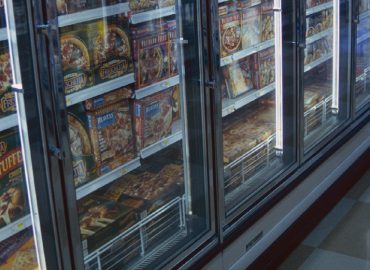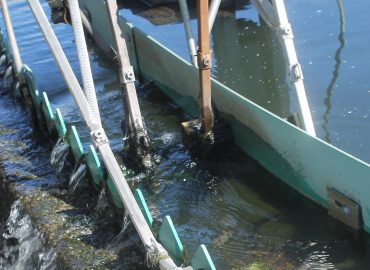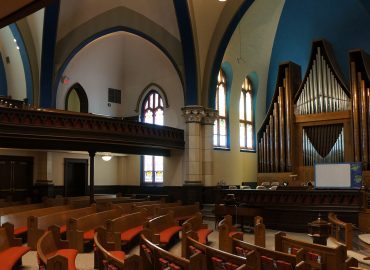Ice arenas are large energy users, but there are often ample opportunities for energy cost savings. Energy cost reduction measures also often reduce wear on equipment, thus extending its useful life and reducing maintenance requirements. Improvements can be classified into five categories: resurfacing and refrigeration; building envelope; lighting; heating, dehumidification and ventilation; and low-cost or no-cost efficiency improvements which, even with limited budgets can be implemented to begin saving money and energy.
Many communities across the state of Illinois have ice arenas. By their nature, these buildings are large energy users. The Smart Energy Design Assistance Center (SEDAC) can assess how well your particular facility is performing, compared to other similar facilities, and then identify ways to save energy and money. A survey of ice arenas in Quebec found that the least efficient ice arenas consumed almost three times as much energy as the most efficient ice arenas. (1) This wide range in energy consumption suggests that there are ample opportunities for energy cost savings in many ice arenas. Some energy cost reduction measures also reduce wear on equipment, thus extending its useful life and reducing maintenance requirements. Improvements can be classified into five different categories: resurfacing and refrigeration; building envelope; lighting; heating, dehumidification and ventilation; and low-cost or nocost efficiency improvements which, even with limited budgets can be implemented to begin saving money and energy. In an ice arena, two main factors influence energy costs: 1) the refrigeration system and associated tasks for operations and maintenance of the ice sheet, and 2) heating, ventilation, and dehumidification of the stands, rink, locker rooms, and common areas (such as lobbies). There are opportunities to update the refrigeration, ventilation, and heating systems, and to integrate heating and refrigeration systems (with heat recovery). Many of these cost saving opportunities are available with very reasonable payback periods and can lead to up to 40% energy savings. This brochure highlights some of these opportunities.
Typical ice arena energy usage


To determine where to spend money for the greatest return on investment, it is helpful to know what systems consume the most energy. Figure 1 illustrates typical energy use in an ice arena. Not surprisingly, the refrigeration system consumes the greatest amount of energy (45% of total energy use). To better understand refrigeration energy use, it is important to look at the loads on the refrigeration system. Table 1 shows a breakdown of the different loads on the refrigeration system. The seven main loads on the system are heat gain from air convection, heat gain from ceiling radiation, ground heat gains from below ice slab and heat gains in coolant piping headers, ice resurfacing, lighting, coolant pump, and skaters.
Energy savings measures
Building controls
Ice arenas can save a lot of energy by adding or modifying controls and making operational adjustments. These adjustments are either free or very low cost.
- Increase ice temperatures during unoccupied periods, free skating, and figure skating.
- Reduce ice sheet thickness.
- Use reduced or floating head pressure controls on the refrigeration system (this will reduce effectiveness of heat recovery. Cost savings analysis can balance the trade-off between an improved refrigeration cycle or a more efficient heating cycle).
- Program night setbacks on space heating and ventilation.
- Reduce coolant flow rate according to schedule and occupancy.
Lighting

High efficiency lighting improvements are a cost-effective way to reduce electricity use for lights, reduce the amount of heat input from lights, and lower electricity and refrigeration costs.
- Reduce light intensity over the stands.
- Install LED lights.
- Consider occupancy sensors for areas with intermittent use
- Upgrade to a highly reflective ceiling to reduce lighting requirements (or use low-e paint).
- Consider modulating lighting levels according to the activities taking place (Table 2 shows recommended illumination levels for Minnesota’s public ice arenas).
Building envelope

Reducing radiative heat gains to the ice by making adjustments to the building envelope greatly reduces the load on the refrigeration system. A very common and effective solution is to install a low-emissivity radiant ceiling barrier. This highly reflective barrier is usually a polished aluminum surface laminated to a vinyl, polypropylene, or fiberglass backing. It is suspended from the ceiling as illustrated in Figure 2. The barrier shields the ice surface from being exposed to the warm ceiling surface, thus reducing radiative heat gains.
Additional building envelope recommendations include:
- Properly insulate walls and roof.
- Install insulated doors to reduce conduction losses.
- Replace worn weather-stripping & caulking for airtightness.
Heating, ventilation, and humidity control
Heat recovery
Ice arenas have substantial refrigeration and heating loads, making them prime candidates for waste heat recovery from the refrigeration process. Waste heat can be used to heat sub-slab brine, control the temperature and humidity of the interior climate, heat resurfacing hot water, or melt ice scraped off by the resurfacer. Heat recovery on exhaust air to preheat incoming outdoor air should also be considered.
Convective gains
Convective gains occur when forced air heating systems for the rink and stands disturb the air stratification above the ice sheet, creating air currents that increase refrigeration loads. These convective gains can be reduced by minimizing heating and ventilation and by only heating spectator areas when occupied. Outdoor air can be controlled using CO2 sensors for locker rooms and common areas and CO2 sensors for rink areas to remove pollution from the fossil-fueled resurfacing machine exhaust. Ventilation flow rates can be lowered using variable frequency drives (VFDs) on the air handler motors.
Space heating
Reducing space heating also lowers the load on the refrigeration system. This load can account for more than 30% of the refrigeration system’s energy consumption. Conditioning and refrigeration loads can be reduced by lowering set point temperatures in the stands, particularly during unoccupied periods. Ideally, ventilation should be supplied only to maintain indoor air quality. Heating of spectator areas should be accomplished using radiant heating systems (floor or infrared). Savings are also possible by installing programmable controls that save 5-15% of annual refrigeration costs.
Resurfacing 
Refrigeration systems
Possible energy cost reduction options include compressor sequencing, floating head pressure, variable flow or dual-drive brine pumps, variable frequency drives on evaporators, high efficiency motors and soft-start controllers. The best way to evaluate the advantages of improvements is to simulate the operating equipment.
Ice sheet aspects
The thickness and temperature of the ice sheet and how it is maintained all impact energy use. Different activities need different surface temperatures. Hockey requires hard ice and figure skaters prefer soft ice, so brine temperatures must be adjusted accordingly. Keeping the temperature of the ice as high as possible reduces refrigeration loads, and increasing the ice temperature a single degree can save 6% annually in refrigeration costs. Consider raising the ice temperature when the rink is unoccupied.
The ice surface temperature can be determined with an infrared sensor. The sensor is typically mounted or hung above the ice from a beam or score clock and oriented down at the ice. This type of sensor provides better control of the ice surface temperature than embedded sensors. The thickness of the ice also affects the temperature at which the brine must be circulated to chill the ice. The thicker the ice, the cooler the brine must be, and cooler brine creates greater refrigeration loads. Equipment is available to automatically reset brine temperatures based on a schedule of events throughout the day. Note that to drop brine temperature 2°F takes only one to two hours if the ice is kept thin (about 1”). It is possible to save up to 8% of compressor energy consumption when variable brine temperatures are implemented. If variable temperature brine controls are installed, we recommend placing a separate slab sensor to monitor ice temperatures and ensure that the ice performs as required, independent of other loads.
Maintenance and resurfacing
City water is heated and transferred to the ice resurfacing machine to provide a better bond to the ice sheet and to melt and fill in cracks caused by skate blades. By switching to demineralized water the need for heating is eliminated because pure water bonds very easily to the existing ice sheet. Two additional benefits of using unheated demineralized water are that the cooler resurfacing water reduces the load on the refrigeration equipment, and pure water provides a harder ice surface that is more resistant to cuts. Water can be demineralized using either an ion-exchange method or a reverse osmosis filter; however, reverse osmosis will increase water usage. Electric versus internal combustion powered ice resurfacing machines also impact energy use. We recommend switching to an electric resurfacer to improve interior air quality and reduce the amount of outside air required for human comfort.





